
Buprestidae is a family of beetles known as jewel beetles or metallic wood-boring beetles because of their glossy iridescent colors. Larvae of this family are known as flatheaded borers. The family is among the largest of the beetles, with some 15,500 species known in 775 genera. In addition, almost 100 fossil species have been described.
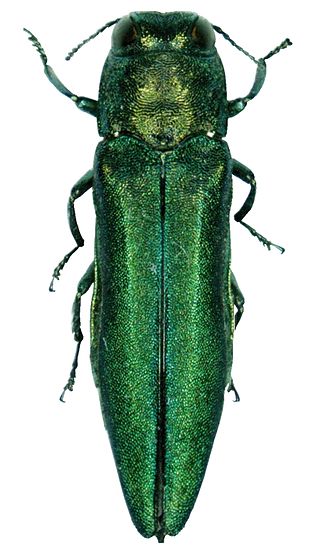
The emerald ash borer, also known by the acronym EAB, is a green buprestid or jewel beetle native to north-eastern Asia that feeds on ash species. Females lay eggs in bark crevices on ash trees, and larvae feed underneath the bark of ash trees to emerge as adults in one to two years. In its native range, it is typically found at low densities and does not cause significant damage to trees native to the area. Outside its native range, it is an invasive species and is highly destructive to ash trees native to Europe and North America. Before it was found in North America, very little was known about emerald ash borer in its native range; this has resulted in much of the research on its biology being focused in North America. Local governments in North America are attempting to control it by monitoring its spread, diversifying tree species, and through the use of insecticides and biological control.

Agrilus anxius, the bronze birch borer, is a wood-boring buprestid beetle native to North America, more numerous in warmer parts of the continent and rare in the north. It is a serious pest on birch trees (Betula), frequently killing them. The river birch Betula nigra is the most resistant species, other American birches less so, while the European and Asian birches have no resistance to it at all and are effectively impossible to grow in the eastern United States as a result.

Fraxinus pennsylvanica, the green ash or red ash, is a species of ash native to eastern and central North America, from Nova Scotia west to southeastern Alberta and eastern Colorado, south to northern Florida, and southwest to Oklahoma and eastern Texas. It has spread and become naturalized in much of the western United States and also in Europe from Spain to Russia.
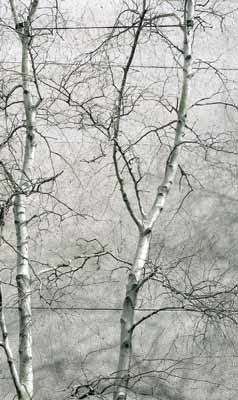
Betula populifolia, known as the gray birch, is a deciduous tree in the family Betulaceae. It is native to eastern North America and is most commonly found in the northeast United States as well as southern Quebec, New Brunswick, and Nova Scotia. The tree is a pioneer species that is commonly found in sites following disturbance, such as fire or logging. Gray birches don't have as much economic value as other birch species but are still commonly used as ornamental trees.

Cleridae are a family of beetles of the superfamily Cleroidea. They are commonly known as checkered beetles. The family Cleridae has a worldwide distribution, and a variety of habitats and feeding preferences.

Chionanthus virginicus is a tree native to the savannas and lowlands of the northeastern and southeastern United States, from Massachusetts south to Florida, and west to Oklahoma and Texas.

Tremex columba, also known as the pigeon tremex or pigeon horntail, is a species of horntail that is native to eastern and western North America.
Conotrachelus elegans, the pecan gall curculio, is a true weevil species in the genus Conotrachelus. It is found in North America where it feeds on galls of the hickory leaf stem gall phylloxera, found also on pecan.

Oobius agrili is a parasitic non-stinging wasp of family Encyrtidae which is native to North Asia. It is a parasitoid of the emerald ash borer, an invasive species which has destroyed tens of millions of ash trees in its introduced range in North America. As part of the campaign against the emerald ash borer (EAB), American scientists in conjunction with the Chinese Academy of Forestry searched since 2003 for its natural enemies in the wild leading to the discovery of several parasitoid wasps, including Oobius agrili, which is a solitary egg parasitoid of EAB found on ash trees in Jilin province in 2004; it has been recorded to kill up to 60 percent of EAB eggs.
Dicerca tenebrica, the flatheaded wood borer or flatheaded poplar borer, is a brassy to black coloured beetle from Chrysochroinae subfamily which can be found in Canada and both Southern and Northeastern United States. The species was first described by William Kirby in 1837.
Dicerca hesperoborealis is a species of metallic wood-boring beetles in the family Buprestidae. It is found in North America.
Dicerca lepida, the embossed hawthorn buprestid, is a species of metallic wood-boring beetle in the family Buprestidae. It is found in North America and varies in size between 13.5 and 17.5 millimetres.
Dicerca juncea is a species of metallic wood-boring beetle in the family Buprestidae. It is endemic to the Southeastern United States, with the type material from the Florida, Alabama, and Georgia. It is an elongate beetle of about 14.2 mm (0.56 in) length.

Nothopleurus lobigenis, the southwestern stump borer, is a species of long-horned beetle in the family Cerambycidae. It is found in Central America and North America.
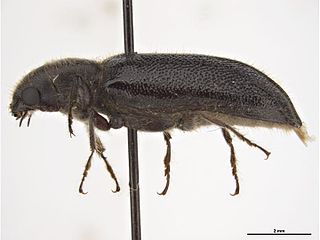
Melalgus plicatus is a species of horned powder-post beetle in the family Bostrichidae. It is found in Central America, North America, and South America.

Melalgus is a genus of horned powder-post beetles in the family Bostrichidae. There are more than 20 described species in Melalgus.
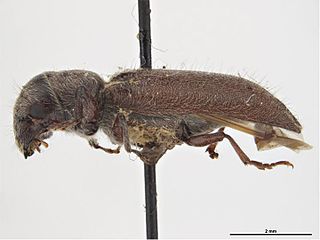
Melalgus confertus, known generally as the branch and twig borer or grape cane borer, is a species of horned powder-post beetle in the family Bostrichidae. It is found in North America.
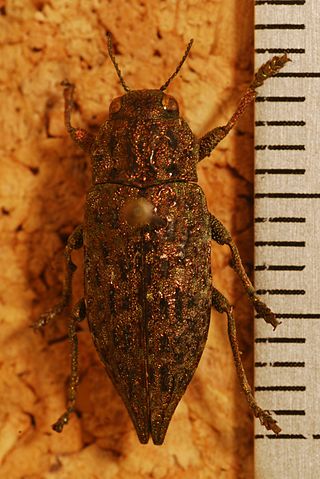
Dicerca tenebrosa, the flatheaded conifer borer, is a species of metallic wood-boring beetle in the family Buprestidae. It is found in North America.

Arrenodes minutus, commonly known as the oak timberworm, is a species of primitive weevil in the family Brentidae. These beetles are pests of hardwoods in North America. Adult oak timberworms are shiny, elongate, and range 7 to 25 mm in length. They are reddish-brown to brownish-black in coloration, with yellow spots on their elytra. Adults display strong sexual dimorphism; females have long, slender, straight mouthparts, while males possess flattened, broadened mouthparts with large mandibles. Males are known to be aggressive and use these large mandibles for combat. These mandibles are also used in courtship. Larvae are elongate, cylindrical, white, and curved. They have 3 pairs of jointed legs on the thorax and 1 pair of prolegs near the end of the abdomen.














